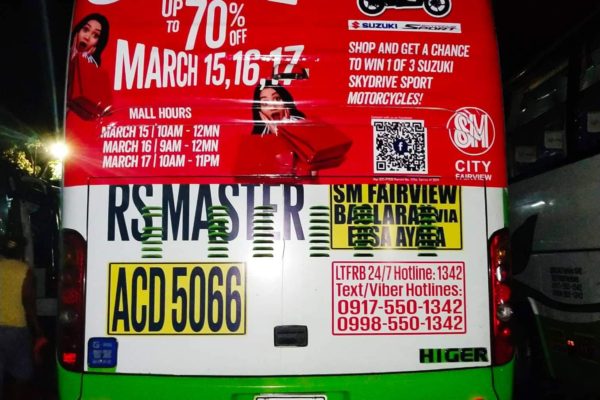Effective Transit Advertising Philippines to Grow Your Target market
Effective Transit Advertising Philippines to Grow Your Target market
Blog Article
Just How Transportation Marketing Can Change Mass Transit Spaces Into Dynamic Advertising And Marketing Platforms
Transit advertising and marketing holds substantial possibility to redefine public transport spaces into vivid marketing platforms that educate and involve. As we discover the diverse benefits and advancing approaches of transportation advertising and marketing, it raises the concern of just how this improvement can redefine our interactions with both brand names and the urban setting.
Advantages of Transit Advertising

Additionally, transit marketing is extremely cost-effective compared to traditional media. It permits marketers to achieve high impressions at reduced costs, making best use of return on investment. The restricted audience of travelers provides an opportunity for brands to share their messages to individuals that are typically receptive throughout their travel times.
Furthermore, the dynamic nature of transit marketing enables campaigns to be updated often, guaranteeing that messaging continues to be prompt and relevant. This adaptability can be crucial in replying to market trends or marketing events, keeping the brand name top-of-mind for consumers. Finally, the pervasive visibility of transportation advertising and marketing adds to brand name recall; repeated exposure within acquainted travel contexts enhances brand awareness and cultivates consumer commitment, inevitably boosting and driving sales brand online reputation.
Sorts Of Transportation Marketing
Public transportation systems offer numerous formats for advertising and marketing, each providing to various advertising techniques and target market involvement approaches. One prominent type is exterior bus and train wraps, which cover the whole automobile and produce a mobile billboard effect, allowing for high exposure in metropolitan atmospheres. These wraps can capture focus as they traverse active roads, getting to a varied target market.
One more preferred layout is interior advertising and marketing, that includes posters, digital displays, and ads on transportation seats. These placements engage guests during their trip, strengthening brand name messaging in a restricted area. Digital displays, specifically, use the benefit of dynamic web content, allowing advertisers to upgrade messages in real-time.
Terminal advertising and marketing is also considerable, including posters, banners, and interactive stands within transit stations. These ads take advantage of foot web traffic and can target particular demographics based on place.
Last but not least, advertising partnerships with transportation authorities can bring about distinct projects, such as themed transportation experiences or occasions, boosting the general engagement with commuters. Each kind of transportation advertising and marketing supplies distinct advantages, permitting brand names to tailor their strategy to effectively reach their target audience within the public transportation environment.
Engaging Travelers Efficiently
Travelers are significantly swamped with advertising and marketing messages throughout their day-to-day journeys, making it crucial for brands to involve them in ingenious methods. To record interest in this jampacked room, marketers should focus on creative thinking and importance. Making use of captivating visuals and succinct messaging can dramatically improve the possibility of involvement.
Interactive elements, such as QR codes or enhanced truth functions, can also transform fixed ads right into immersive experiences, fostering a deeper link with the target market. Brands need to focus on attending to commuters' rate of interests and requirements, tailoring messages to resonate with their way of life, whether via promos for neighborhood businesses or solutions designed to improve their travelling experience.
Moreover, timing plays a vital role; tactically placing ads throughout optimal commuting hours can make the most of presence and influence. Involving commuters effectively also includes leveraging social networks assimilation, allowing passengers to share their promos or experiences straight from transportation systems, therefore intensifying brand name reach.
Basically, efficient involvement depends upon comprehending the traveler trip and developing engaging, interactive, and pertinent advertising and marketing experiences that not just catch focus yet also drive action and commitment. By doing so, brand names can change mass transit right into a vibrant marketing platform that reverberates with its audience.

Measuring Advertising And Marketing Impact
Just how can brands accurately analyze the efficiency of their marketing campaign en route settings? Determining the effect of transit marketing requires a complex method that combines measurable and qualitative metrics. One widespread approach is tracking engagement via mobile analytics, where brand names can examine foot website traffic patterns and app communications in the past, throughout, and after campaigns.
Studies can offer valuable insights right into brand name recall and customer belief, enabling brands to gauge exactly how well their messages reverberate with travelers. Furthermore, keeping track of social networks engagement pertaining to certain projects can expose changes in public assumption and brand discussion.

Moreover, working together with transit visit the site firms can enhance dimension precision, as they often have thorough group information on ridership fads. By incorporating these approaches, brand names can develop an extensive understanding of their advertising and marketing effectiveness, ensuring that their projects not just reach yet likewise influence their target audiences effectively.
Future Patterns en route Advertising
A considerable change is prepared for en route advertising as technological improvements and transforming customer actions reshape the landscape. Transit Advertising Philippines. The combination of interactive media and electronic display screens is expected to enhance involvement, enabling brands to deliver vibrant material that reverberates with diverse audiences. As public transport systems embrace clever innovation, marketers will take advantage of real-time data analytics to tailor messages based on passenger demographics and actions
Furthermore, enhanced fact (AR) is positioned to change the method travelers connect with promotions. By giving immersive experiences, AR can change an ordinary trip into an engaging story that records attention and fosters brand name commitment. This technology will likely encourage advertisers to create more experiential projects that drive consumer communication.
Sustainability is one more crucial trend influencing transportation marketing. As environmental awareness expands, brands will significantly look for to align with environmentally friendly techniques, utilizing lasting materials and advertising eco-friendly efforts within their campaigns.
Conclusion
In final thought, transit advertising and marketing provides considerable benefits by enhancing brand name visibility and involving a captive target market. As trends advance, the potential for innovative communications in between brands and travelers is positioned to expand, guaranteeing that transit marketing stays an important component of modern marketing approaches.
Transportation marketing holds significant potential to redefine public transport spaces into vibrant advertising platforms that engage and educate. The prevalent visibility of transit advertising contributes to brand name recall; repeated direct exposure within acquainted travel read review contexts enhances brand name awareness and fosters customer loyalty, inevitably enhancing and driving sales brand name credibility.
Exactly how can brand names properly assess the performance of their advertising campaigns in transportation settings?In conclusion, transportation marketing offers considerable advantages by improving brand visibility and engaging a captive audience. Transit Advertising Philippines. As patterns progress, the possibility for cutting-edge interactions in between brand names and travelers is poised to expand, making click this link sure that transit advertising and marketing continues to be an essential component of modern advertising approaches
Report this page